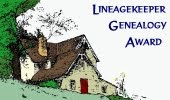During their holiday family gatherings, they shared their lineal information and in some cases the wall charts they'd had printed at BYU with their families. Everyone was delighted to see the information. In fact, exploration of the data took over the conversation.
As they poured over the data, different family members found that I had missed some of their lineage. In one case, the chief of a large
 Indian Nation was missed along with four generations of his descendants. In another case, another Native American branch was missing.
Indian Nation was missed along with four generations of his descendants. In another case, another Native American branch was missing.I didn't find this information because it wasn't listed in the resource documents and websites that I use for research. The lineages probably would have remained blank except for the knowledge of different members of each of these families. In one case, a brother said, "Part of this line is missing! Mom, do you remember that old book you have in storage? It lists our Indian ancestry!" They found the book, dusted it off and indeed, the missing lineage was listed on the pages.
The assembled work and charts had fulfilled my expectations. Entire families became interested in their lineage. They quickly organized themselves to continue their ancestral quest. Missing data, known only to one member of the group was 'found' again, even though it had long been in the possession of the family.
Such is the power of organized family research, be it an organization of siblings and parents or an organization of extended cousins. Collective research results always exceed the efforts of any single individual. Collectively viewing the information for accuracy, missing data and 'mining' of the group memory almost always results in brick walls being pulled down and light shining on family members long since lost to history.
If you haven't formed a family organization yet, now is the time to make it your New Years resolution.
An organization will help bring concentrated focus to missing individual and family records. Like concentrated rays from the sun through a magnifying glass, the concentrated efforts of members in the organization will be equally effective in burning through the thrash and clutter that hide the facts. It will expose the gems of truth that have 'always been there awaiting discovery' --- Lost - Now Found.






















